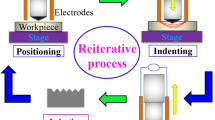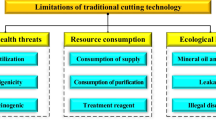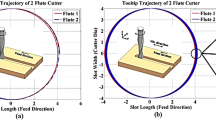Abstract
Ultrasonic vibration and magnetic field complex–assisted techniques have been used in low-speed wire electrical discharge machining (USV-MF complex–assisted WEDM-LS) to improve workpiece surface quality. In this paper, a novel approach, which is based on a three-dimensional successive discharge model, is proposed to investigate the interaction between the workpiece surface forming and the vibration of a wire electrode. The influence of USV-MF complex–assisted technique on workpiece surface forming and vibration of a wire electrode is considered by modifying the parameters in this model. During the simulation, the discharge location, which is determined by the minimum gap width in each step, makes it possible to calculate the vibration of a wire electrode in the successive discharge process. Workpiece surface topographies are obtained at the end of simulation, as well as the vibration responses of the wire electrode and the distribution of discharge locations. The simulation results show that the USV-MF complex–assisted technique can increase the vibration amplitude of the wire electrode by 1.12%. The surface roughness values decrease more than 10% and the distribution uniformity of discharge location increases in the USV-MF complex assisted WEDM-LS process. The simulation results are verified by experiments and simulation error of surface roughness value is less than 5% compared with the experimental results. The analysis shows that the servo feed speed increases more than 50% with surface quality unaltered in the USV-MF complex–assisted WEDM-LS process.



















Similar content being viewed by others
References
Abbas N M, Solomon D G, Bahari M F (2007) A review on current research trends in electrical discharge machining (EDM). Int J Mach Tools Manuf 47(7-8):1214–1228
Hinduja S, Kunieda M (2013) Modelling of ECM and EDM processes. Cirp Annals-Manufacturing Technology 62(2):775–797
Ho K H, Newman S T (2003) State of the art electrical discharge machining (EDM). Int J Mach Tools Manuf 43(13):1287– 1300
Izquierdo B, Sanchez J A, Ortega N, Plaza S, Pombo I (2011) Insight into fundamental aspects of the EDM process using three-dimensional numerical simulation of microelectric multidischarge numerical simulation. Int J Adv Manuf Technol 52(1-4):195– 206
Kuriachen B, Varghese A, Somashekhar K P, Panda S, Mathew J (2015) Three-dimensional numerical simulation of microelectric discharge machining of Ti-6Al-4V. Int J Adv Manuf Technol 79(1-4):147–160
Yu Z Y, Kozak J, Rajurkar K P (2003) Modelling and simulation of micro EDM process. Cirp Annals-Manufacturing Technology 52(1)
Singh A, Ghosh A (1999) A thermo-electric model of material removal during electric discharge machining. Int J Mach Tools Manuf 39(4)
Tao J, Ni J, Shih A J (2012) Modeling of the anode crater formation in electrical discharge machining. Journal of Manufacturing Science and Engineering-Transactions of the Asme 134(1):11
Yue X M, Yang X D (2015) Molecular dynamics simulation of the material removal process and gap phenomenon of nano EDM in deionized water. Rsc Advances 5(82):66502–66510
Yue X M, Yang X D (2017) Molecular dynamics simulation of material removal process and crystal structure evolution in EDM with discharge on different crystal planes. Int J Adv Manuf Technol 92(9-12):3155–3165
Dhanik S, Joshi S S (2005) Modeling of a single resistance capacitance pulse discharge in micro-electro discharge machining. Journal of Manufacturing Science and Engineering-Transactions of the Asme 127(4):759–767
Das S, Joshi S S (2010) Modeling of spark erosion rate in microwire-EDM. Int J Adv Manuf Technol 48(5-8)
Chen Z, Zhang G J, Han F L, Zhang Y M, Rong Y M (2018) Determination of the optimal servo feed speed by thermal model during multi-pulse discharge process of WEDM. Int J Mech Sci 142:359–369
Jameson E C (1970) Electrical discharge grinding. IEE, pp 135–142
Izquierdo B, Sanchez J A, Plaza S, Pombo I, Ortega N (2009) A numerical model of the EDM process considering the effect of multiple discharges. Int J Mach Tools Manuf 49(3-4):220–229
Assarzadeh S, Ghoreishi M (2017) Prediction of root mean square surface roughness in low discharge energy die-sinking EDM process considering the effects of successive discharges and plasma flushing efficiency. J Manuf Process 30:502–515
Guo Z, Lee T, Yue T, Lau W (1997) Study of ultrasonic-aided wire electrical discharge machining. J Mater Process Technol 63(1-3):823–828
Guo Z, Lee T, Yue T, Lau W (1997) Study on the machining mechanism of WEDM with ultrasonic vibration of the wire. J Mater Process Technol 69(1-3):212 – 221
Chen Z, Zhang Y M, Zhang G J, Huang Y, Liu C H (2017) Theoretical and experimental study of magnetic-assisted finish cutting ferromagnetic material in WEDM. Int J Mach Tools Manuf 123:36–47
Zhang Z, Huang H, Ming W Y, Xu Z, Huang Y, Zhang G J (2016) Study on machining characteristics of WEDM with ultrasonic vibration and magnetic field assisted techniques. J Mater Process Technol 234:342–352
Wang Y, Wang Q, Ding Z J, He D X, Xiong W, Chen S Y, Li Z X (2018) Study on the mechanism and key technique of ultrasonic vibration and magnetic field complex assisted WEDM-ls thick shape memory alloy workpiece. J Mater Process Technol 261:251–265
Shabgard M R, Gholipoor A, Mohammadpourfard M (2018) Numerical and experimental study of the effects of ultrasonic vibrations of tool on machining characteristics of EDM process. Int J Adv Manuf Technol 96 (5-8):2657–2669
Jeswani M L (1978) Roughness and wear characteristic of spark-eroded surfaces. Wear 51(2):227–236
Roy T, Datta D, Balasubramaniam R (2018) Numerical modelling and simulation of surface roughness of 3-d hemispherical convex micro-feature generated by reverse micro-EDM. Int J Adv Manuf Technol 97(1-4):979–992
Author information
Authors and Affiliations
Corresponding author
Ethics declarations
Conflict of interest
The authors declare that they have no conflict of interest.
Additional information
Publisher’s note
Springer Nature remains neutral with regard to jurisdictional claims in published maps and institutional affiliations.
Rights and permissions
About this article
Cite this article
Wang, Y., Chen, SY., Xiong, W. et al. Study on workpiece surface forming mechanism by successive discharges during USV-MF complex–assisted WEDM-LS process. Int J Adv Manuf Technol 108, 2985–3000 (2020). https://doi.org/10.1007/s00170-020-05406-7
Received:
Accepted:
Published:
Issue Date:
DOI: https://doi.org/10.1007/s00170-020-05406-7




